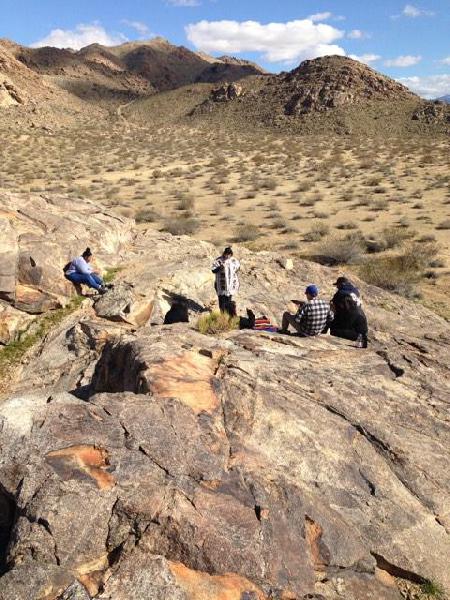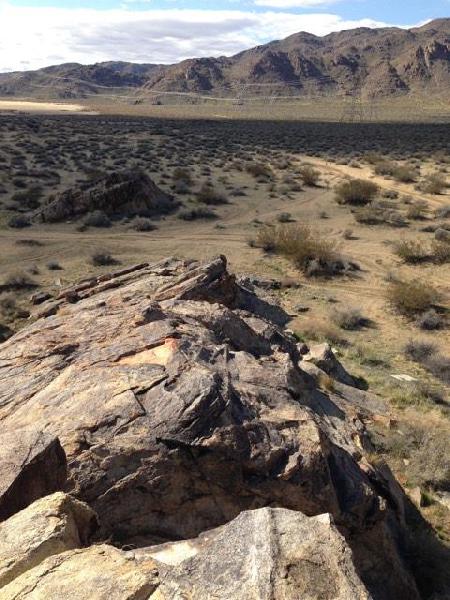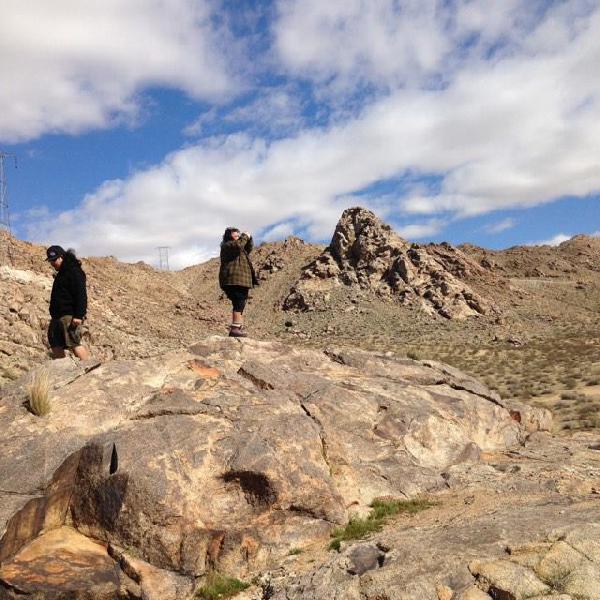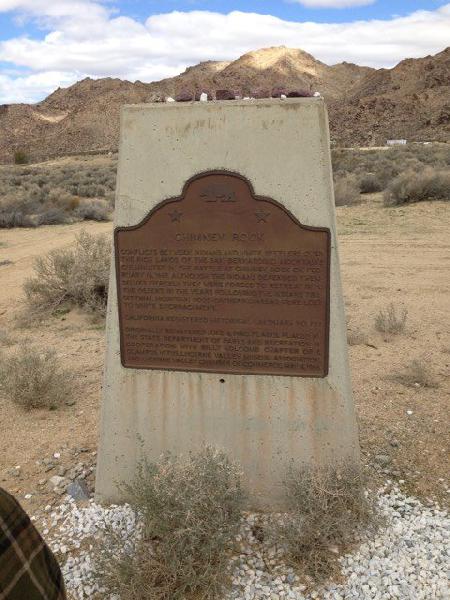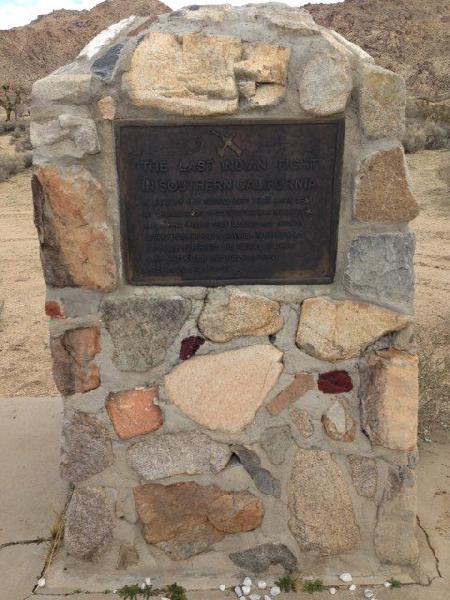The Indigenous Defense and Resistance Unity Movement, better known as iDRUM, has been active for approximately three years in the inland region of Southern California in rallying the community to support indigenous activists on the frontlines of land and water defense struggles, including against the Keystone XL Pipeline in Lakota territory and against the Dakota Access Pipeline, also being routed through Sioux lands near the Standing Rock reservation.1 The group has also led protests against the Ontario-based SafariLand, LLC, which was implicated in violence against water defenders at Standing Rock,2, 3as well as informational sessions about the Nestlé corporation's theft of water from the San Bernardino mountains, which it markets as the "Arrowhead" brand of bottled water.4, 5
But another element of iDRUM's work is the recovery of historical memory about the inland area, including learning about sacred sites and uncovering the hidden history of the genocide that occurred in the region. To this end, the group has visited the Maze Rock near Hemet, the geoglyphs at Blythe, and the site of the village of Jumuba. In researching the local history, the group discovered the Chimney Rock incident, but until today, had not visited the site.
Research about the incident--which was actually a series of skirmishes spanning from about the time of the Mormon settlement and that culminated in the massacre of February 16, 1867--is difficult due to scanty, conflicting and highly-unreliable materials written from the perspective of the genociders. Until very recently, materials from the Native perspective have been unavailable to outsiders.
But from what we can piece together from these materials, as well as from a general understanding of the landforms, Native and settler cultural patterns, and the principles of low-intensity warfare, it went down pretty much like this:
Although the entire continent had been affected by the plagues that spread from nation to nation after the arrival of European pirates in 1492, until 1813, encroachment inland had been relatively minimal. But that year, Yuhaviatam (aka Serrano) supported Tongva relations in a raid on the San Gabriel Mission and were thereafter pursued into the mountains, where Spanish soldiers killed several warriors and took some prisoners.
The incident, although minor in the large scheme of history, remained in the social consciousness of the local tribes--a memory which was revived just a few years later in 1819, when the Catholic fathers established an "asistencia" (a sort of outpost of the San Gabriel Mission) near the Cahuilla village of Guachama in what is now Redlands--the first of its kind in the inland area. Thereafter, the situation deteriorated rapidly.
The next few years brought a rapid succession of changes that would greatly impact the region: Mexico won its independence from Spain and the land, while legitimately Indian, was nominally transferred from the possession of the Kings of Aragon and Castille to the government of Mexico. Meanwhile, those rapacious white settlers who had not long ago thrown off the yoke of the British kings who sought to limit their domination of the North American continent, had begun to explore California to see what natural resources they might exploit here. An advance scout for white American settlers named Jedediah Smith passed through in 1826, and in the same year a wagon trail was forged over the existing Indian trail running south through the Cajon Pass.
White American settlers got their biggest break after 1834, when the Mexican government took control of the missions and their surrounding lands from the Church and began distributing it as spoils to the heirs of the soldiers of the conquest of California and to some enterprising white Americans whose loyalty and "industriousness" they thought they could buy with acreage. (Incidentally, inland Natives also saw the secularization of the missions as an opportunity--not for a land grab, however, but rather to restore the precolonial equilibrium. They united and successfully destroyed the "asistencia" in a series of attacks, effectively ending the mission to San Bernardino.)
While indigenous communities sought to restore their way of life, land in the area continued to change hands between and amongst different Californios and white American settlers. But it was not long before continental power struggles would take their effect in inland Southern California, when the end of the American war of aggression of Mexico ended in 1848 and settlers rushed in pursuing gold. Under the Bear Flag, Natives were massacred mercilessly by order of the territorial governor and local authorities. By 1850, California was officially a US state, and by 1851, the Mormons had arrived in San Bernardino from their principal settlement on Paiute lands in today's Utah.
This new incursion was also resisted by warriors led by Antonio Gara, but they were unable to prevent the Mormons from building a sawmill in the mountains north of the fort in what is now downtown San Bernardino--Yuhaviat territory. This sawmill, necessary to support the lumber needs of the settlers, represented an imminent threat to the way of life of the Yuhaviatam, who traditionally subsisted on acorns and pine nuts, gathered from the trees in the mountains, and who supplemented their diets by hunting game in those same forests. A threat to the trees was a threat to the food source, and therefore, survival, and was met with the necessary gravity.
In an abortive attempt at peace, official representatives of settlers and Natives signed the 1852 Treaty of Temecula, which would have guaranteed Serranos and other groups rights to large tracts of land. The US Senate, however, failed to ratify the treaty.
In 1857 and 1858, the Mormon settlers were urged to return to Utah. Although many did, the infrastructure of white American colonization had already been laid down. Eighteen-sixty saw several important developments that would intensify the conflict: The first was William F. Holcomb and Ben Choteau's discovery of gold in Yuhaviat lands renamed the "Holcomb Valley," leading to gold rushes there and in Lytle Creek (north of today's Fontana). The second was a drought that began to affect vegetation in the region, making food resources more scarce for both Native and settler alike.
At about that time, Holcomb took credit for killing all the bears in the Holcomb Valley.6 The Yuhaviatam never killed bears, honoring them as close relatives and as incarnations of ancestors.7
In the first major militarization since the arrival of the Mormon Batallion, the US military established "Camp Cady" to protect whites travelling the Mojave Trail into the Holcomb Valley.
White american colonization intensified in 1862 when the US Congress passed the Homestead Act, which codified the process of dispossesion of Native lands.
Here documents from settlers begin to discuss bloodshed in Yuhaviat lands. They highlight the killing of a "Spanish man" by Indians at the mouth of Little Sand Canyon in the San Bernardino mountains (near the top of today's Sterling Avenue north of the city of Highland), as well as a skirmish that resulted in injury to a doctor in the area. At this, a vengeance posse was formed and the "offenders" were hunted, but never located.
These documents also discuss an Indian being killed by a settler named S.P. Waite at about this time, but essentially exculpate him of any wrongdoing: first by "contextualizing" the murder in relation to the death of the Spanish Polito and the injury to the physician, Dr. Smith, and then by claiming (almost ridiculously) that Waite had been aiming at "something a bluejay was darting after." It is clear that the settlers harbored resentment against the Native peoples in general for inhabiting lands they wished to claim, and in specific for having dared to defend themselves with violence against the white Polito and Smith. They held onto this resentment for several years, just waiting for the opportunity to exact revenge.
That opportunity came in 1866 when Ed Parrish, Nephi Bemis, and Pratt Whiteside, all white, were killed in a conflict with a group of Natives at a place called Dunlap Ranch. Shortly thereafter, a raiding party took provisions from the houses of some settlers in Little Bear Valley and burned down a house. They were chased by a small vigilante group and another skirmish ensued. The band of racists called for backup from the mill and from down the hill in San Bernardino.
For the next several days, this vigilante group hunted down the Indians, stalking them all the way through the mountains and into the high desert and through the Lucerne Valley. The racists split into two groups and closed in, and a battle ensued. By the time the dust had settled, the band of Natives had scattered. Only five that had not managed to escape were kidnapped.
The following day the posse regrouped and pursued the fleeing group--this time the confrontation was a climactic scene at the dry lake bed at the base of Chimney Rock and in the surrounding rocks. Here, however, the paper trail dries up. There is no explanation of what happened to the five captives--two women, a teenaged boy, a ten-year-old girl, and a baby--and more importantly, no body count or account of what happened to the victims. (We have a clue in that one of the accounts of the genociders estimates that 150-200 Indians were in the group that was being pursued. On the issue of how many were killed and how many survived by "scattering," the author is deafeningly silent.) No names of victims are given.
However, where the narrative of the white settlers ends, a few Native sources pick up. The most prominent among them is the official version of events put forth by the Yuhaviatam now resident at the San Manuel Reservation. They tell of their coming to being permanently restricted to those lands following the Chimney Rock massacre, and detail the role of their leader, Santos Manuel (the reservation's namesake), in heroically leading the survivors to safety there:
"In 1866, unrest came to the area as militia forces from San Bernardino killed Serrano men, women, and children in a 32-day campaign. Yuhaviatam tribal leader Santos Manuel safely led the remaining Yuhaviatam from their ancient homelands in the mountains to [the] valley floor."8
The tribe was officially granted the reservation in 1875, a mere eight years after the incident.
Oral history, now recorded and transcribed by Native scholars, sheds further light on the struggle and the climate in which it took place.
A recent publication quotes a descendant of the massacre:
"Believe that at Chimney Rock it should say Paiutes, not Chemehuevi, there was a mixture of both and it was written wrong. It was a 32-day battle. Some of the Militia died here, but not many, they were well armed. They had weapons while the Natives were only armed with bows. The Native people chose this spot. . . . My uncle told me to look for springs and if you go into the rock, there is water and they chose this place for the battle because they knew there was water and a lot of rattlesnakes. Militia, name was Holcombe, at that family had a lot of land, by Big Bear and there were mercenaries chasing them, they got money for killing Indians, they got money for taking down Indians, paid by scalp. That was the proof that you killed an Indian; was by the scalp. . . . These markers don’t tell you about that. Many of my relatives died here, it was like the end, yet our stories still survive."9
Despite these valuable insights--which, we should point out, in highlighting the valor and heroism of strong Native leaders, providing insight on the development of military strategies, contextualizing incidents within the framework of genocidal policy, and deliberately charting narratives that run counter to the canon, educate about what "[t]hese markers don't tell you about,"--we still have many basic questions unanswered.
Who was killed? Mojaves? Kitanemuk? Vanyume? Serrano? Payuchi? Chemehuevi?
How many?
What were their names?
Obviously, we would want to know their names so we can read them aloud every February 16 much as the members of the Jewish community read the names of those who were killed in the Holocaust. But not only do we not know their names, but we do not even know what nations they came from. The textual sources variously refer to Paiute and Chemehuevi being either the responsible for the aggressions against white settlers, or being the victims of the campaign, or both. Some sources say that the Paiutes were likely to have conducted the raids on the houses and the arsons, while the Serrano were merely the scapegoats who suffered the wrath of the settlers' vengeance. This last explanation is the only one that makes sense. In light of the direct threat against Serrano--the settlement on their lands, the logging of the trees pledged to their descendants, and the attack on their ancestors the bears--it is not unlikely that they had planned some military action, particularly against the sawmill. But would they take elderly people and children on such a military mission? Unlikely. What is more likely is that the residents of one of the mountain villages descended into the desert to the north to escape the cold and snow of the winter, to do some hunting (there's a reason the nearest street is called Rabbit Springs Road) and to have access to fresh water (the dry lake bed fills up after showers and the bed across the street from the dry lake bed was full of water while we were there.)
The nomadic Utes and Paiutes--especially after gaining use of the horse--were known to send raiding parties down through the passes to retrieve stored grains such as acorns that the Serrano and Cahuilla kept in granaries, so it is not unlikely that they sought this sort of relief from the drought, whether by raiding Serrano settlements or by shifting to raids on white settlers. Might there have been collaboration between different tribes to strike at, confuse, or undermine white settlers? The history of cross-tribal collaboration across long distances makes the possibility a very real one.
A close examination of the monuments themselves is warranted in arriving at conclusions not only about the incident itself but also about the power relations behind the construction of narratives about intergroup contact.
The text of the monument we presume to be the earlier of the two reads, "In January 1867 Indians left their camp east of Chimney Rock to go into the San Bernardino Mountains where they looted and burned several cabins and a sawmill. In retaliation, a possee [sic] surprised the Indians at their camp and killed and wounded many, thus ending the hostilities." The language criminalizes Natives taking action against land theft, justifying--but importantly, acknowledging--bloodshed at the hands of white settlers.
The second, we presume, of the two monuments, is very similar in form--it constitutes a bronze plaque set into a rock-and-mortar base--but its language is subtly different: "Conflicts between Indians and white settlers over the rich lands of the San Bernardino Mountains culminated in The Battle at Chimney Rock on February 16, 1867. Although the Indians defended themselves fiercely, they were forced to retreat into the desert. In the years following, the Indians' traditional mountain food-gathering areas were lost to white encroachment."
Here the culprit is not overt racial violence but rather what later societies viewed as "inevitable," the "progress" of "civilization." Human rights abuses are recharacterized as a "battle" in which one party "retreated." In this version, the matter is settled; the war is over--"the food-gathering areas were lost."
In the change of the messages across the two monuments, we see both a softening and an erasure of the traces of racial violence. Despite the slight difference in message, we see monuments that were placed by the "victors" of history--monuments to the heroicism of the conquerors.
Despite the historiographical erasure of violence through official markers, the reality is that a massacre happened up there. The irony, given the dearth of details about the victims, is that we know fairly precisely the identities of the perpetrators.
Their names were Jack Martin, Samuel Bemis, Edwin Bemis, Bill Bemis, Harrison Bemis, Bart Smithson, John McGarr, Johnathan Richardson, Frank Blair, George Armstrong, George Birdwell, Joseph Mecham, Jack Ayres, George Miller, David Wixom, ‘Noisy’ Tom Enrufty, Sam Button, a man named Stout (called a "preacher"), Stout’s son and a man named Griffith and named as a son-in-law to the "preacher" Stout.10
They were led by John St. John and William F Holcomb--the same Holcomb who claimed to have rid the Holcomb Valley of bears and whose family ended up playing a leading role in the politics of the San Bernardino Valley for many generations.
While the first monument is unattributed, the second is placed jointly between government, semi-government, and "civic" organizations, in 1986. Among the organizations credited are the California Department of Parks and Recreation, the Lucerne Valley Museum Association, the Lucerne Valley Chamber of Commerce, and the Billy Holcomb Chapter of E Clampus Vitus.
The chapter of the pseudo-historical society that is partially credited with placement of the marker at Chimney Rock takes its name from this Holcomb. Given the public activities of the chapter, which is active, we can deduce some of the motives for its placement. It is a chapter whose cultivation of a drunken and sarcastic image of an unapologetic "pioneer" reveals continued ambitions of white domination and a glorification of that domination's historical legacy, precisely through the placement of such plaques. A perusal of their websites reveals photos of numerous such plaques, as well as descriptions of chapter events in overtly racial terms.11
Given this situation, looking at this data, at the land, and examining the oral histories that have now been incorporated into the literature, we must re-examine the text the public sees on the monuments in question, as well as the motives behind their placement. We must ask ourselves, should we be allowing the only monuments that mark the spot of a large-scale massacre whose memory has been swept under the rug to be placed by settlers and their descendants and to honor the perpetrators, rather than the victims of the genocide? I think the answer is clear.
1. Indigenous DRUM. https://www.facebook.com/indigenousDRUM/
2. X. "Standing Rock Solidarity Action" December 11, 2016. http://la.indymedia.org/news/2016/12/294370.php
3. Alive Today. "Stop Safariland," December 14, 2016. https://www.youtube.com/watch?v=v1gG29AO1pU
4. Weekes, Brianna. "Defending the Sacred: Discussion on Native American Land." The Redlands Bulldog, October 17, 2016 http://www.theredlandsbulldog.com/defending-the-sacred-discussion-on-native-american-land/
5. Indigenous DRUM. "Thank you to everyone who came out..." Facebook.com, January 31, 2017. https://www.facebook.com/indigenousDRUM/posts/740653386097848
6. Burr Belden, J. "HOLCOMB VALLEY GOLD DISCOVERY," n.d. Billy Holcomb Chapter of E Clampus Vitus. http://www.legacy.billyholcomb.com/holcomb_valley_gold_discovery.htm
7. Different sources talk about the reverence Serrano or Yuhiavatam hold for bears, including Johnston, Francis J. The Serrano Indians of Southern California. Banning: Malki Museum Press (1980) and Trafzer, Clifford. The People of San Manuel. Patton: San Manuel Indian Reservation, 2002.
8. San Manuel Band of Mission Indians. "History," 2017. https://www.sanmanuel-nsn.gov/Culture/History
9. Olague, Emmanuel, quoted in Fenelon, James and Trafzer, Clifford. "From Colonialism to Denial of California Genocide to Misrepresentations: Special Issue on Indigenous Struggles in the Americas" February 21, 2014. American Behavioral Scientist 58:3
10. For the information about the unfolding of events and the names of the members of the posse, I relied heavily on Lazenby, Cindy. "Chimney Rock," conveniently available at http://www.lucernevalley.net/history/chimney_rock.htm
11. For example, the "events" page of the Billy Holcomb Chapter of E Clampus Vitus calls the "cactus Cantina" where monthly chapter meetings are held a place "where the Air is Brown and the Trash is White". https://www.billyholcomb.com/events/




